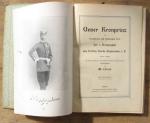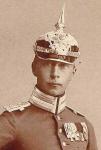-
Posts
2,234 -
Joined
-
Last visited
-
Days Won
55
Content Type
Profiles
Forums
Blogs
Gallery
Events
Store
Everything posted by Glenn J
-
Dr Funcke's promotions: Assistenz-Arzt I. Klasse: 22.6.76 Stabsarzt: 24.5.81 Oberstabsarzt II. Klasse (ohne Patent): 28.9.92 Oberstabsarzt II. Klasse: 22.11.92 Overstabsarzt I. Klasse/Oberstabsarzt: 3.9.97 N char. Generaloberarzt: 17.5.10 He retired from his position with Bezirkskommando Elberfeld on 17 May 1910. Regards Glenn
-
Dave, Olivier Freiherr v. Beaulieu-Marconnay's last pre-war appointment was as commandant of Borkum, provisionally from 22 March 1912 and then definitively from 31 May 1912. He was placed as disposal on 10 June 1913 with the uniform of Leib-Grenadier-Regiment Nr. 109. He became the Oberhofmeister of the Gro?herzogin of Sachsen-Weimar. On the 1st of October 1916 he was appointed as Chief of the Central Department of the General Staff (Home Command) and promoted to Generalmajor z.D. on 15.7.18. His mobilisation appointment was terminated on 31 December 1918. Regards Glenn
-
Claudio, Rick, Paul Kayser, born 8 May 1878 in Finsterhagen, Gotha as the son of Oberf?rster Albert Kayser. Attended the Kaiser Wilhelms Akademie from 30 Marcch 1897 to 1 October 1901 when he was assigned to Infanterie-Regiment Prinz Louis Ferdinand von Preu?en (2. Magdeburg.) Nr. 27 on promotion to Unterarzt. Doctorate on 17 February 1903 and commissioned as an Assistenzarzt on 19 May 1903 (19.5.03 B) on transfer to Feldartillerie-Regiment Prinz-Regiment Luitpold von Bayern (Magdeburg.) Nr. 4. Promoted to Oberarzt on 18 July 1905 (18.7.05 E2e) he was transfered to the Sanit?tsamt of the IV. Armeekorps on 21 July 1906 until 18 May 1908 when he was assigned to 8. Th?ring. Infanterie-Regiment Nr. 153 at Altenburg. Shortly after on 1 June 1908 he was attached to the 1st Surgery Department of the General Hospital in Hamburg-Eppendorf. Promoted to Stabsarzt (ohne Patent) on 27 January 1911 he was assigned as the battalion medical officer of II./Infanterie-Regiment Freiherr Hiller von Gaertringen (4. Pos.) Nr. 59 where he received a Patent of 21.2.11 C2c the following month. His last pre-war assignment was as an instructor at the Kaiser Wilhelms Akademie to which he was assigned on 18 February 1913. He retired as an Oberstabsarzt. Regards Glenn
-
Dave, having not looked at a printed Rang- und Quartier-Liste from this early before I am not in a position to offer clarification but perhaps only the regular permanent staff officers or "Stamm" personnel of Landwehr formations were listed. I will check out "Das Preu?ische Heer in den Jahren 1814 und 1815" next week in Potsdam. Regards Glenn
-
Bob, no problem and I can confirm the the Feuerwerker book lists Herr Fuchs with an EK1 but does not give any indication of the award date. Frustratingly, the wartime editions of the Milit?r-Wochenblatt listed Bavarian winners of the EK1 but not the Prussians! If you need the scans again I can of course do that. Regards Glenn
-
Justin, I will be able to look at a copy of the 1817 Rang- und Quartier-Liste in a couple of weeks time. That being the case I will see if he is still listed then and if he had any awards. Similarly "Das Preu?ische Heer in den Jahren 1814 und 1815" has a Landwehr Rangliste from 1814 appended which I will check. Regards Glenn
-
Bob, he presumably simply volunteered as a Kriegsfreiwilliger or War Volunteer. According to the provisions of the Army Law (Section 98), all replacement formations could accept volunteers. That being the case he would have reported to the depot of Pionier-Bataillon von Rauch and signed on. If his intention was to eventually become a Festungsbau-Offizier, then he would have had to have first become a Pionier Non Commissioned Officer prior to attending the Festungsbau-Schule. Regards Glenn
-
The Prussian War Ministry Order No. 865/11. 96 K.M. dated the 13th of February 1897 titled "Distinguishing between same named Officers" finally abolished the practice of using numbers to differentiate between same named officers in the same rank in the same unit. It stipulated that from henceforward officers of the same name and rank in the same unit (including officers of the same branch and rank in a Landwehrbezirk) should be distinguished by their given name. This alleviated somewhat the confusing picture in the larger Landwehrbezirks where one could perhaps have as many as 5 or 6 Sekonde-Lieutenant M?llers Regards Glenn
-
Marcin, In one word - yes. Young men could initially volunteer for two, three or four years active service in the army or navy and additionally for five or six year engagements with the navy. The volunteer (in the case of the army) like the "one Year Volunteer" could choose the unit in which he wished to serve. Permission from the Civilian member of the recruiting commssion to allow voluntary service was dependant on the permission of the father or guardian and also the good conduct of the volunteer in question. Unlike the "one Year Volunteer", these volunteers were clothed and equipped as normal and were not considered prospective reserve officer aspirants. Volunteers under twenty could also seek acceptance in an NCO school which then mandated a 4 year engagement on graduation. Regards Glenn
-
Bob, regarding IR. 401: Infanterie-Regiment 401 was formed on the 10th of June 1916 under the auspices of the XX Army Corps Home Command as "Infanterie-Regiment Allenstein". It received the number 401 on the 5th July 1916. Subordinated to the 402. Infanterie-Brigade, 201. Infanterie.Division (as were IR. 402 & IR. 403), it was commanded by Major (Oberstleutnant 18.4.17 F) Hans Hermann Geiseler formely of Infanterie-Regiment Nr. 60. Unfortunately an history of this regiment was not published. Regards Glenn
-
Bob, the German "official" history - Der Weltkrieg 1914-1918, volume 11 probably does not add to what you already know. It devotes one paragraph to the assault at Skrobowa as follows: "On the 9th of November Army Group Woyrsch undertook a well prepared assault in order to win back the lost positions north of Baronowicze in the July battles in the sector of the Austro-Hungarian XII Korps. Deploying flamethrowers, the 5. Reserve and elements of the 201. Infanterie-Division threw back the enemy on a 4 kilometre wide front behind the Skrobowa stream and took over 4000 prisoners, 27 machine guns and 12 mortars." Regards Glenn
-

Portrait of Georg F?rst Musikmeister
Glenn J replied to Robert Noss's topic in Germany: Weimar Republic & Deutsche Freikorps
Robert, another superb portrait of Herr F?rst. By the way, I identified your original photo on WAF in October 2005 http://www.wehrmacht-awards.com/forums/sho...ead.php?t=96252 Regards Glenn -
Robert, the Kronprinz wears the uniform of the 1. Garde-Regiment zu Fu?. The shoulder boards appear to have been altered to make them look like those of a Major. Judging by his age and comparing this to another example of this photograph where the boards are more clearly those of an an Hauptmann, I would date it around 1904. Regards Glenn
-
mossop, a Napoleonic Landwehr M?ller will be extremely problematical. I am unaware of any regimental history from that period for that regiment. Similarly, the 1812 Rangliste as I remember (the handwritten facsimile) only listed regulars. As an historical footnote, prior to 1867 all non regular officers were termed Landwehr then following the Defence Law of 9 November 1867 the two distinct groups were created - Reserve and Landwehr Regards Glenn
-
Hi Mossop, The odd lists are available dating back to that period, for example 1806, 1808 & 1812. The latter I know is available as a facsimile of a handwritten list and not terribly user friendly without an index. The printed lists were published again on an annual basis from 1817 onwards. As Bob alluded to earlier, they can be a little frustrating without giving given names or even initials. It was not until around the turn of the century that even officers in the same regiment of the same rank were differentiated by their Christian names! The earliest list in my possession is 1866. Regards Glenn







